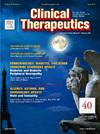Polyneuropathy in Parkinson's Disease is Highly Prevalent and Not Related to Treatment
IF 3.2
4区 医学
Q2 PHARMACOLOGY & PHARMACY
引用次数: 0
Abstract
Purpose
An increased prevalence of peripheral polyneuropathy (PN) in Parkinson's disease (PD) associated with greater functional impairment has previously been reported. A possible cause has been suggested as levodopa therapy. The aim of this real-world study was to assess the prevalence and the characteristics of PN in PD and to investigate the putative association between PN and oral levodopa.
Methods
A cohort of 692 consecutive patients with idiopathic PD had routine clinical, laboratory, and lower limb clinical neurophysiology assessment when attending the certified tertiary Parkinson center, Schön Klinik Neustadt, Neustadt in Holstein, Germany, between 2016 and 2019. Patients were sent by general neurologists for the medication adjustment, physiotherapy, ergotherapy, and logopaedic treatment. A retrospective cross-sectional review of the data was performed.
Findings
The mean age of the cohort was 72.6 (8.44) years (range, 44–90 years) and 60% were male. The age of the first PD manifestation was 65.22 (10.09) years (range, 31–88 years). Of 692 patients with PD, 507 (73.27%) had clinical signs of neuropathy and PN was first diagnosed 6.3 (5.7) years after the PD onset. Of these 507 patients, 446 (87.96%) underwent the electrophysiological investigations with PN confirmed in 396 patients (88.79% out of 446 electrophysiologically investigated patients with PD). Peripheral polyneuropathy was ruled out in 50 patients (11.21% of 446 electrophysiologically investigated patients with PD). The half of patients had moderate and severe sensory axonal PN (201 patients or 53.03% of all 396 with confirmed PN). The mean motor examination part of the Movement Disorders Society's Unified PD Rating Scale score in patients with PN was significantly higher (off, 30.48 [11.60] points; on, 19.92 [10.27] points), than in patients without PN (off, 27.17 [14.57] points; on, 17.14 [11.98] points), with P < 0.01 in the both off and on states.
The mean levodopa daily dosage was similar in patients with PN and without PN (565 mg vs 556 mg, P = nonsignificant). No difference between other dopaminergic medication in PN and non-PN group was found.
Implications
PN is highly prevalent in patients with PD. There was no association between oral levodopa or other dopaminergic medication and PN. More awareness of PN in PD clinics and further understanding of the pathophysiology, which leads to the development of an axonal polyneuropathy in PD, are required.
帕金森病的多神经病变非常普遍,与治疗无关。
目的:帕金森氏病(PD)中周围多神经病变(PN)的患病率增加与更大的功能损害相关,此前已有报道。一个可能的原因是左旋多巴治疗。这项现实世界研究的目的是评估PD中PN的患病率和特征,并调查PN与口服左旋多巴之间的推定关联。方法:在2016年至2019年期间,692名连续的特发性PD患者在德国荷尔斯泰因的三级帕金森中心Schön Klinik Neustadt接受常规临床、实验室和下肢临床神经生理学评估。患者由神经科全科医师进行药物调整、物理治疗、角疗和骨科治疗。对数据进行回顾性横断面回顾。研究结果:队列的平均年龄为72.6(8.44)岁(范围44-90岁),60%为男性。首次出现PD的年龄为65.22(10.09)岁(范围31-88岁)。在692例PD患者中,507例(73.27%)有神经病变的临床症状,在PD发病6.3年(5.7年)后首次诊断出PN。在这507例患者中,有446例(87.96%)接受了电生理检查,其中396例(446例电生理调查的PD患者中有88.79%)确诊为PN。50例患者(446例PD电生理学调查患者中的11.21%)排除了周围多神经病变。半数患者有中重度感觉轴突PN(201例,占396例确诊PN的53.03%)。运动障碍学会统一PD评定量表中运动检查部分平均评分在PN患者中显著较高(off, 30.48[11.60]分;on, 19.92[10.27]分)比无PN患者(off, 27.17[14.57]分;on, 17.14[11.98]分),off和on状态P < 0.01。有PN和无PN患者的平均左旋多巴日剂量相似(565 mg vs 556 mg, P =无统计学意义)。PN组与非PN组其他多巴胺能药物治疗差异无统计学意义。意义:PN在PD患者中非常普遍。口服左旋多巴或其他多巴胺能药物与PN无关联。需要在PD临床中提高对PN的认识,并进一步了解导致PD轴突多神经病变发展的病理生理学。
本文章由计算机程序翻译,如有差异,请以英文原文为准。
求助全文
约1分钟内获得全文
求助全文
来源期刊

Clinical therapeutics
医学-药学
CiteScore
6.00
自引率
3.10%
发文量
154
审稿时长
9 weeks
期刊介绍:
Clinical Therapeutics provides peer-reviewed, rapid publication of recent developments in drug and other therapies as well as in diagnostics, pharmacoeconomics, health policy, treatment outcomes, and innovations in drug and biologics research. In addition Clinical Therapeutics features updates on specific topics collated by expert Topic Editors. Clinical Therapeutics is read by a large international audience of scientists and clinicians in a variety of research, academic, and clinical practice settings. Articles are indexed by all major biomedical abstracting databases.
 求助内容:
求助内容: 应助结果提醒方式:
应助结果提醒方式:


